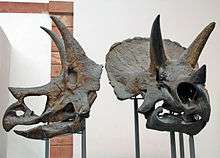Naturmuseum Senckenberg

The Naturmuseum Senckenberg in Frankfurt am Main is the second largest museum of natural history in Germany. It is particularly popular with children, who enjoy the extensive collection of dinosaur fossils: Senckenberg boasts the largest exhibition of large dinosaurs in Europe. One particular treasure is a dinosaur fossil with unique, preserved scaled skin. The museum contains a large and diverse collection of birds with 90,000 bird skins 5,050 egg sets 17,000 skeletons and 3,375 spirit specimens. In 2010, almost 517,000 people visited the museum.[1]
The building housing the Senckenberg Museum was erected between 1904 and 1907 outside of the center of Frankfurt in the same area as the Johann Wolfgang Goethe University, which was founded in 1914. The museum is owned and operated by the Senckenberg Nature Research Society, which began with an endowment by Johann Christian Senckenberg.
Today, visitors are greeted outside the building by large, life-size recreations of dinosaurs, which are based on the latest scientific theories on dinosaur appearance. Inside, one can follow the tracks of a Titanosaurus, which have been impressed into the floor, towards its impressive skeleton on a sheltered patio.
Attractions include a Diplodocus (donated by the American Museum of Natural History on the occasion of the present museum building's inauguration in 1907), the crested Hadrosaur Parasaurolophus, a fossilized Psittacosaurus with clear bristles around its tail and visible fossilized stomach contents, and an Oviraptor. Big public attractions also include the Tyrannosaurus rex, an original of an Iguanodon, and the museum's mascot, the Triceratops.

Although the dinosaurs attract the most visitors due to their size, the Senckenberg Museum also has a large collection of animal exhibits from every epoch of Earth's history. For example, the museum houses a large number of originals from the Messel pit: field mice, reptiles, fish and a predecessor to the modern horse that lived about 50 million years ago and stood less than 60 cm tall.[2]
Unique in Europe is a cast of the famous Lucy, an almost complete skeleton of the upright hominid Australopithecus afarensis. Historical cabinets full of stuffed animals are arranged in the upper levels; among other things one can see one of twenty existing examples of the quagga, which has been extinct since 1883.
Since the remodeling finished in 2003, the new reptile exhibit addresses both the biodiversity of reptiles and amphibians and the topic of nature conservation. An accessible rain forest tree offers views of different zones of the rain forest from the ground to the tree canopy and the habitats to which the exotic reptiles have adapted.
The Senckenberg Museum offers regular evening lectures and tours.
References
- ↑ "(German language article)". Idw-online.de. Retrieved 2013-01-02.
- ↑ "SENCKENBERG world of biodiversity | Museums | Museum Frankfurt | The Museum | Exhibitions | World natural heritage". Senckenberg.de. 20 December 2012. Retrieved 2013-01-02.
External links
| Wikimedia Commons has media related to Naturmuseum Senckenberg. |
- Official website including information in English
- Senckenberg Forschungsinstitut und Naturmuseum Frankfurt, Senckenberg Gesellschaft für Naturforschung on Google Cultural Institute
- Flickr Photos of specimens on the galleries, interior and exterior views.
Coordinates: 50°07′03″N 8°39′06″E / 50.11750°N 8.65167°E